Good Onboarding, Bad Onboarding
January 20, 2025
10 Predictions for 2025
January 1, 2025
Your Remote Team's Blind Spots
April 30, 2023
The 3 Questions Great Product Teams Ask
January 31, 2023
New Year's Resolutions
January 10, 2023
The Spotify Wrapped Growth Engine
January 2, 2023
Stories as a Service
December 19, 2022
Forget Faster Horses
December 12, 2022
Gas isn’t the next Facebook — it’s the next Zynga
December 5, 2022
The Shit Sandwich
April 20, 2022
User Manual to Me
March 24, 2022
The Future of Remote Work is Voice-First
May 31, 2021
Managing Remote Teams
July 6, 2020
AP Johnson — Blog — About
About Me
I've spent the past decade working in product and growth for early and mid-stage startups. These days you can find me in Toronto working on the product team at Mission Lane.
My top reads from the business bookshelf.
🗞️ Startup Resources & Articles
Useful resources on startups, management, product, marketing, and more.
Fun online party games to play with friends or colleagues.
AP Johnson — Blog — About
Work With Me
Drawing from a decade of experience scaling B2B and consumer startups, I help early-stage companies transform their product strategy into measurable growth.I've helped teams boost user activation, optimize conversion funnels, and build scalable growth frameworks that actually work. No theoretical fluff, just practical solutions based on real experience.
I work with a select group of 2-3 startups each quarter, offering both strategic guidance and tactical implementation in product strategy, growth frameworks, and funnel optimization.Ideal clients are B2B SaaS companies with initial traction looking to accelerate their growth. My engagements typically run 3-12 months, ensuring we have time to implement strategies and measure real results.Ready to accelerate your startup's growth? Email me with your company details and key challenges. I offer a free 30-minute discovery call to discuss your needs and explore a potential fit.
AP Johnson — Blog — About
January 20, 2025
Good Onboarding, Bad Onboarding
Most users abandon new products within minutes. The best way to prevent this is through good onboarding, but how do you design one that actually works?Inspired by Ben Horowitz's classic Good Product Manager / Bad Product Manager, here are some dos and don’ts of user onboarding from someone who’s made all these mistakes before.
Good onboarding hooks users with immediate novelty or utility.
Bad onboarding doesn’t give users anything to get excited about.
Good onboarding shows users how the product can be useful to them.
Bad onboarding assumes users already know what the product can do.
Good onboarding tailors the experience to each user’s needs.
Bad onboarding gives each user the exact same experience.
Good onboarding learns enough about users to personalize their experience.
Bad onboarding avoids asking questions to “reduce friction."
Good onboarding simplifies the product experience for first-time users.
Bad onboarding overwhelms users with too much complexity at once.
Good onboarding makes it clear which actions users should take next.
Bad onboarding lets users figure it out on their own.
Good onboarding motivates users by stacking quick wins.
Bad onboarding discourages users with slow time-to-value.
Good onboarding provides contextual help exactly when users need it.
Bad onboarding forces users to dig through documentation to find answers.
Good onboarding has smart defaults and helpful empty states.
Bad onboarding gives users too many choices and too little guidance.
Good onboarding gives users good reasons to return to the product.
Bad onboarding ghosts users after they leave the product.
Thank you to Connor Bradley, Paige Cordero, Karen So, and Paul Peters for reading drafts of this post.
Join my newsletter to get new posts straight to your inbox:
« Previous Post | Next Post »
AP Johnson — Blog — About
January 1, 2025
10 Predictions for 2025
As we kick off 2025, I’d like to try something different.Instead of sharing my own predictions, I'm curious what you think will happen this year.
Will Bitcoin break records?
Could we see peace in Ukraine?
Will Taylor Swift win another Grammy?
I've put together 10 questions spanning politics, sports, culture, and the economy. Next year we'll look back and see who got it right.
I'll share the results next week. Looking forward to seeing your predictions!
Update: January 13, 2025The results are in — here’s what 31 of you think will happen in 2025.
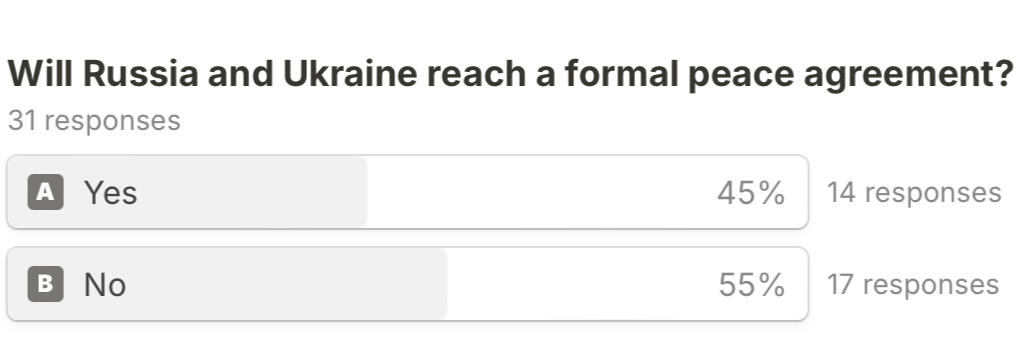
Opinion was pretty split on this one, but it seems like most of you aren’t too optimistic about peace in Ukraine. It’s been almost 3 years since Russia launched its invasion, yet there still aren’t any clear signs of resolution on the horizon.Would love to be proven wrong here.My Prediction: No
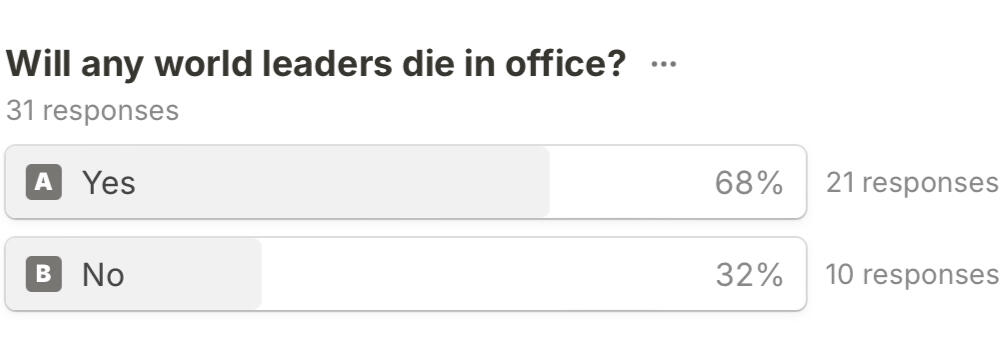
Over two thirds of you think the answer will be yes! And the stats back you up: in the past 5 years, a world leader has died in office each year except 2023.Donald Trump (USA 🇺🇸) led predictions with 6 votes, followed by Volodymyr Zelenskyy (UKR 🇺🇦) with 2 votes. Meanwhile, Vladimir Putin (RUS 🇷🇺), Nicolás Maduro (VEN 🇻🇪), Olaf Scholz (GER 🇩🇪), and Michael D. Higgins (IRL 🇮🇪) each got 1 vote.My Prediction: No
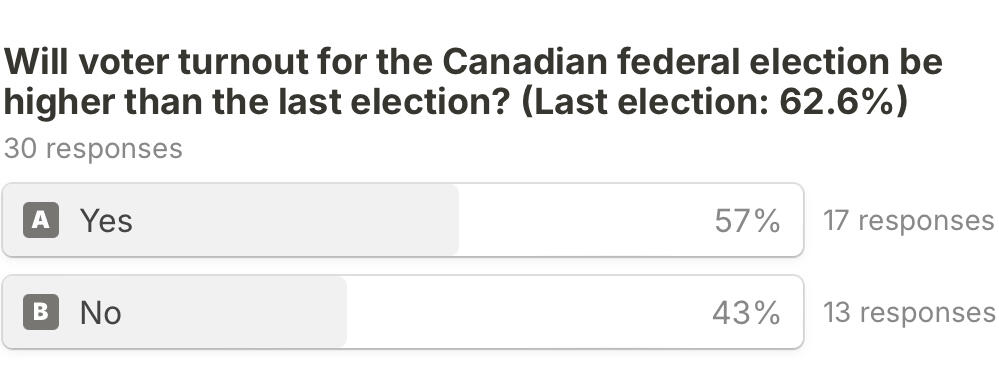
I was surprised by the amount of optimism I saw here, with the majority of you anticipating a higher turnout in this year’s federal election. One of you made a good point, though: the last election was in the middle of the pandemic — which likely suppressed voter turnout quite a bit — so we could expect to see a rebound in 2025.The numbers back up this theory: the 2019 election had a 67% turnout and the 2015 election was even higher at 68.3%. Here’s to hoping you’re right!My Prediction: No – 58%
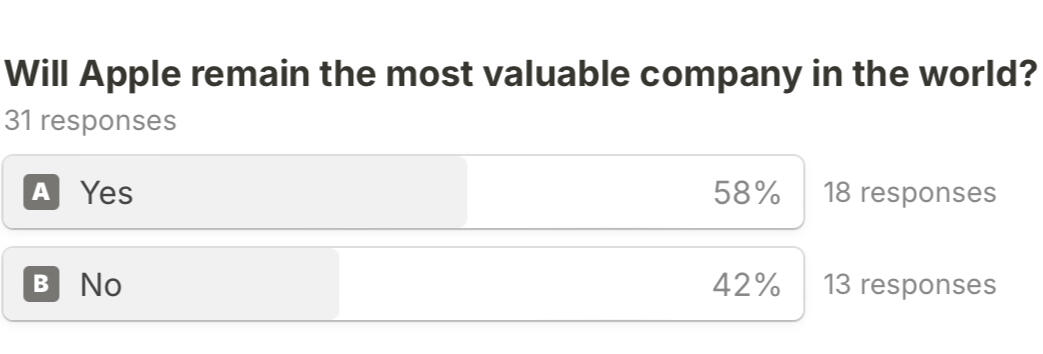
Apple has remained the most valuable company on Earth for the past 5 years and it appears most of you think this will continue into 2026.However, out of those who voted 'No' the top contender to overtake Apple was NVIDIA with 3 votes, while Microsoft, Amazon, and Contemporary Amperex Technology (dark horse!) each got one vote.My Prediction: Yes
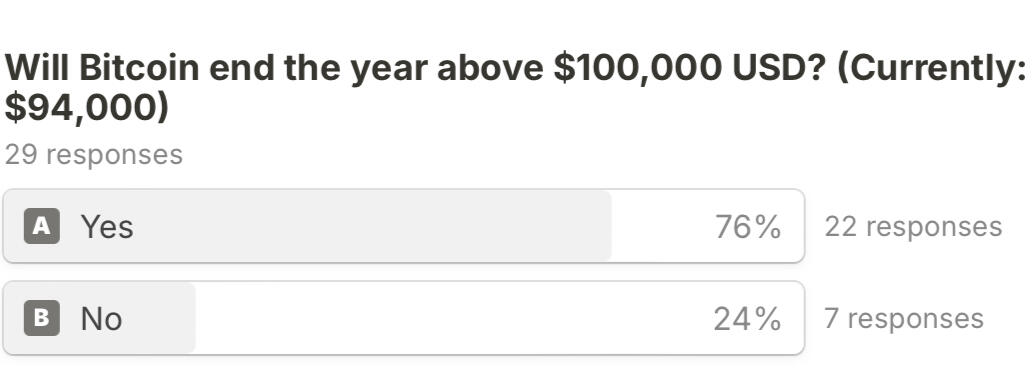
With Bitcoin hitting $100k for the first time last December, the vast majority of you are anticipating its continued rise in 2025. And with the Trump administration expected to introduce more crypto-friendly policies, I can see why.Then again, Bitcoin prices aren’t exactly known for their stability so I’ll be curious to see where this one lands.My Prediction: Yes – $125,000
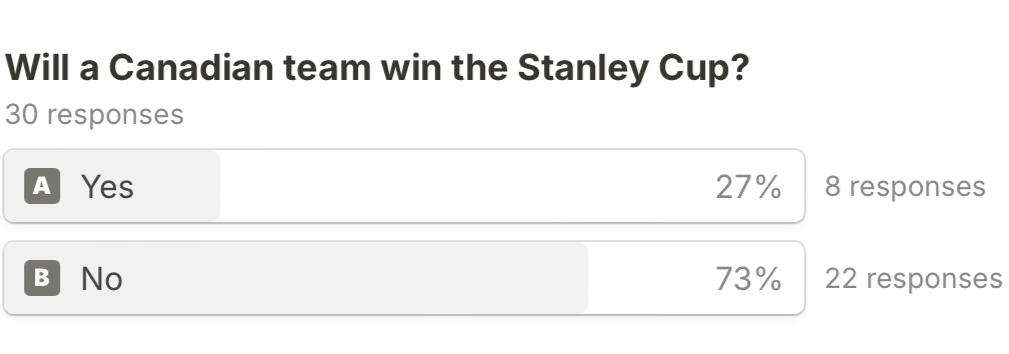
Canadian teams currently make up 3 of the top 8 teams in the NHL, and just last year the Edmonton Oilers were only 1 game away from winning the Cup. This may be one of the best years in recent memory to be a Canadian hockey fan.That said, the last time a Canadian team won the cup (1993) I wasn’t born yet, so I’m siding with the majority vote here — this likely won’t be our year.My Prediction: No – New Jersey Devils
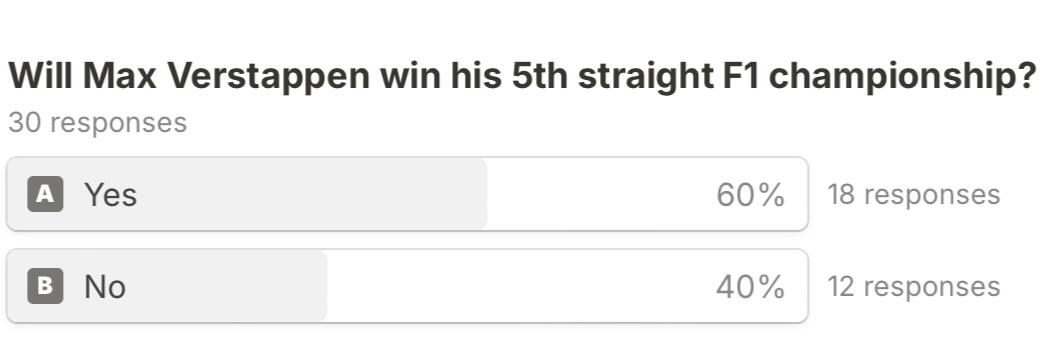
After 4 straight drivers’ championships, most of you are expecting Verstappen to make it 5 this year. However, 2024 was the weakest Red Bull has looked in a long time, and with Ferrari and McLaren hot on their tails I wouldn’t be surprised to see a new champion for the first time since 2020.My Prediction: No – Charles Leclerc
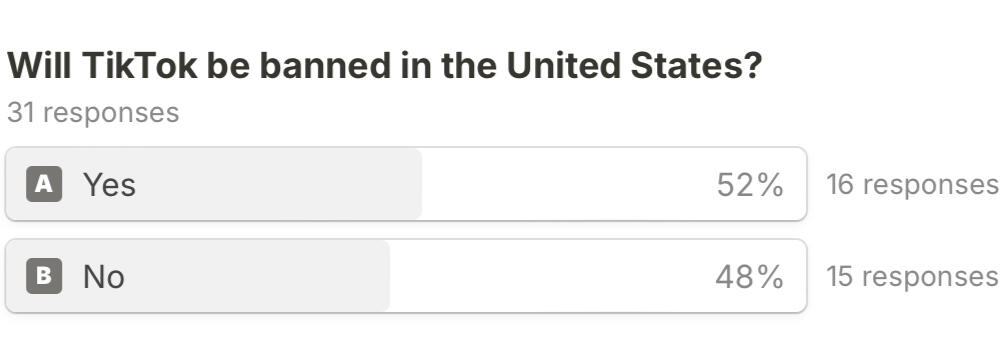
This was the closest one yet, with just one vote splitting the ‘Yes’ and ‘No’ camps. As I write this, it’s looking increasingly likely that the Supreme Court will ban TikTok from American app stores, but with Trump voicing his support for the platform it still remains to be seen how this one will go.My Prediction: No
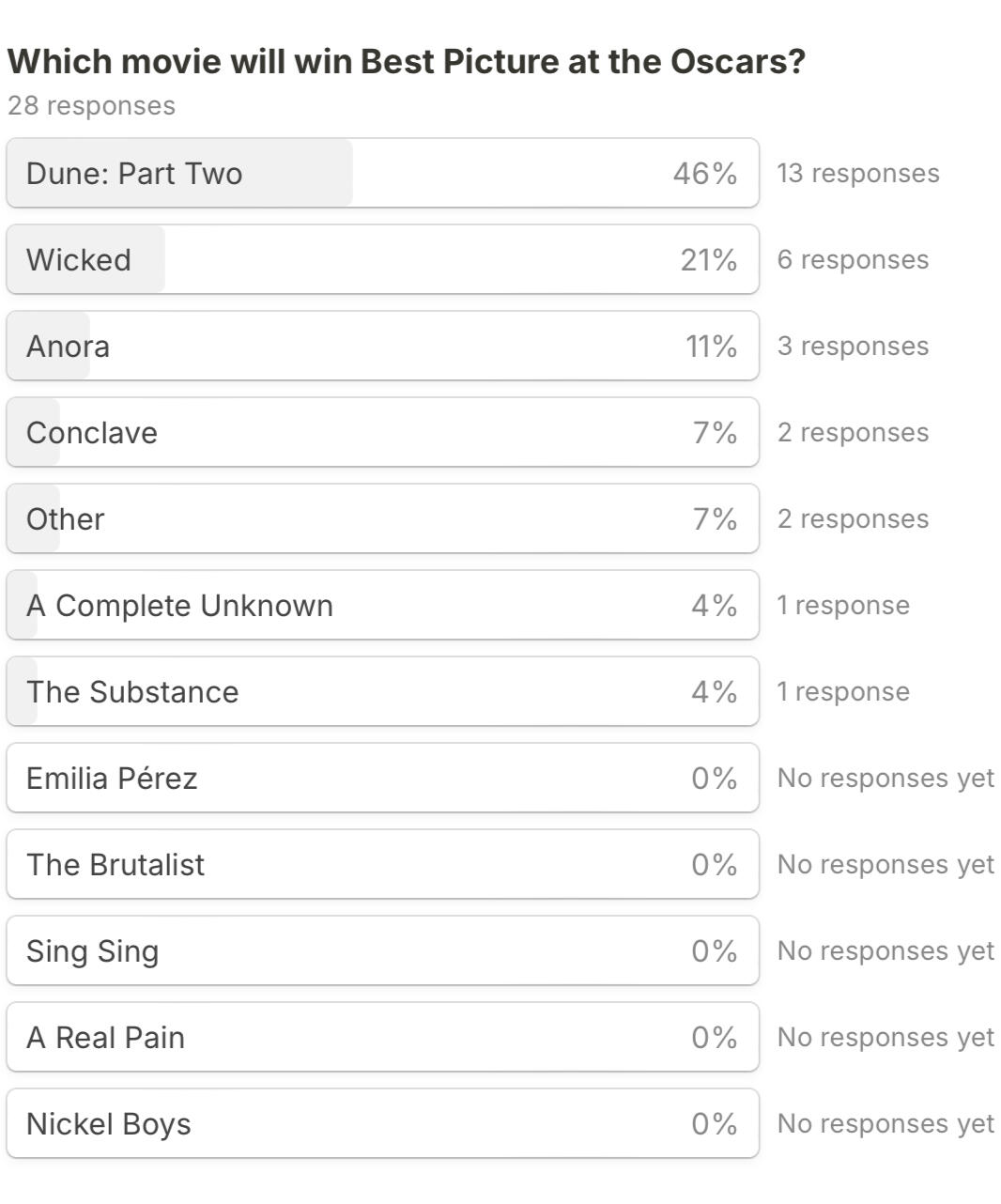
The votes were heavily concentrated on the blockbusters, with Dune: Part Two and Wicked capturing two thirds of all responses. Meanwhile, current Oscar frontrunners Emilia Pérez and The Brutalist went without votes.For what it’s worth, Dune was also my personal favourite film of 2024, but for Oscar predictions I'm placing my bet on the tragic, thrilling, and beautifully crafted Anora.My Prediction: Anora

Coming off her record-breaking Eras Tour, Taylor Swift narrowly edged out Chappell Roan in our poll and it's no surprise why. She’s won this award more times than any other artist and is looking to add a 5th win to her collection.That said, the competition feels particularly strong this year so I’m hopeful that we’ll see a different winner this time around — potentially even a first-time recipient!My Prediction: Billie Eilish - "Hit Me Hard and Soft"
What's your new year's resolution?
While many of us focused on classic goals like meditation, reading, and exercise, I saw several resolutions aimed at emotional growth as well.One that resonated particularly deeply was to “be more kind and understanding with people.” With everything going on in the world right now, I think we could all benefit from a little more kindness and compassion in our day-to-day lives.My Resolution: Learn some jazz piano
Bonus: What's one crazy prediction you have for 2025?
This question produced some pretty great answers, ranging from advances in technology to political upheavals and supernatural events. Here were some of my favourites:
A breakthrough in quantum computing will allow encryption protocols to be cracked within minutes, disrupting cybersecurity globally.
A coup will succeed in a South American country.
JD Vance will be removed as Vice President.
One of the 6 prominent cast members of Seinfeld will pass away (the 4 main plus Newman and Larry David).
Michael Jackson will come back from the dead.
My Prediction: At least one LLM will achieve AGI
See you next January for the results!
Join my newsletter to get new posts straight to your inbox:
AP Johnson — Blog — About
June 26, 2023
Goodbye Jobber, Hello Bonsai
After two years leading activation and onboarding at Jobber, it’s time for me to say goodbye.These past couple years have been truly transformative for me, both on a personal and career level. Having only ever worked at small startups before Jobber, I experienced what it’s like to grow and scale a company post-product-market fit. And boy, what a journey this was!In my two years at Jobber, we doubled our customer base and tripled our revenue while growing the company from 300 to 600+ employees. We raised $100M in the toughest funding market in recent memory, all while maintaining strong business fundamentals throughout.It was a wild ride and an incredible learning experience, and I feel privileged to have worked with such a smart, genuine, and supportive team along the way.
What's Next?
Starting today I will be taking over the core product team at Bonsai, a company that helps self-employed professionals manage their business.Why Bonsai? Three things in particular attracted me to this company and role.
📈 Product-Led Growth
Since its early days, Jobber has built its success on the shoulders of an incredible sales team. Bonsai, on the other hand, doesn’t have a sales team at all. Instead, they rely entirely on the product to sell itself.This leads to a very different approach to building product, with user experience, performance, and design being key differentiators for the business. Having worked on product-led growth motions in the past, I am very eager to jump into a fully product-led company and unlock the next level of Bonsai’s growth together.
🧬 Building Core Product
Most of my career so far has been focused on Growth in all its shapes and forms. I’ve had the chance to impact core product development from the sidelines, but this will be my first opportunity to truly own and lead core product strategy as a whole.While Growth will still be part of my mandate going forward, I’m looking forward to leveraging my perspective and learnings to help build the next phase of Bonsai’s core product.
🤏 Small Team
Large teams have several advantages over smaller ones. They can ship more features, specialize in more areas, and build more complex products. That said, there are two things that small teams are particularly great at: moving fast and taking risks.From my very first conversations with the team at Bonsai, it was clear that they’ve leaned into their strengths as a small team. With only 10 people working on the product, their ability to ship high quality features at a blistering pace has blown me away.This is the number one reason why I am so excited to be joining Bonsai, and I can’t wait to get back to my small startup roots to build something great together.
Acknowledgements
As I begin this new chapter, I want to say a massive thank you to all my Jobber colleagues who made the last two years so memorable. In particular, I would like to thank:
Connor for taking a chance on me as a first-time Product Manager with no prior SaaS experience and being a great mentor along the way. I wouldn’t be where I am today without you.
Ian, Paul, Tyler, Jeewon, Kristen, and Wes for being amazing thought partners, sounding boards, and collaborators. Your patience, feedback, and unflinching candour pushed me to be a better version of myself every day.
David and Karen for sharing the highs and lows of the Growth PM journey alongside me. You were always there to help when I needed it.
And of course, I want to thank Tyze, Lucas, Redon, and the entire Bonsai crew for welcoming me into the team. Looking forward to building the next chapter of Bonsai together!
Join my newsletter to get new posts straight to your inbox:
« Previous Post | Next Post »
AP Johnson — Blog — About
April 30, 2023
Your Remote Team's Blind Spots
I was recently re-reading Elad Gil’s High Growth Handbook¹ and came across this quote from Keith Rabois:
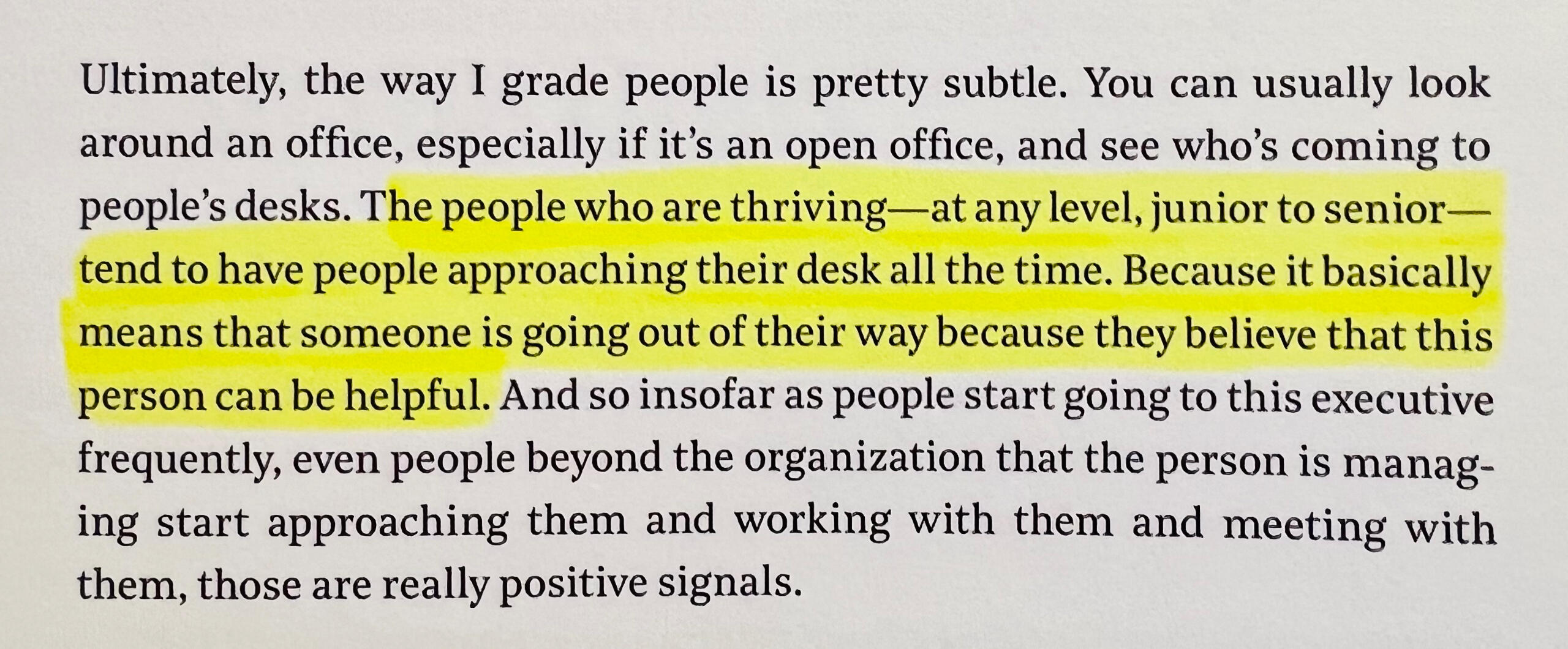
This approach to evaluating employees may have worked when everyone shared an office together, but remote work has changed the game.In remote teams, there is no desk for people to walk up to. Instead, conversations take place in video chats and private messages, out of sight from everyone else. These blind spots make it harder to identify your top performers and allow bad behaviours to go unnoticed for much longer. This can cause organizational damage that’s hard to reverse.
Identifying Top Performers
Your top performers are force multipliers. They don't just do great work, they make everyone around them better.In an office, managers can see these benefits play out every day. They watch top performers help struggling coworkers, share knowledge in casual conversations, and bring energy to team meetings. But in remote teams, these interactions are hidden from view.As a result, remote managers often underrate their best people because they only see part of what they bring to the team. And when top performers feel undervalued, they lose their drive and are more likely to leave. Even if they don't quit, their enthusiasm fades, which hurts the whole team.
Catching Bad Behaviours
Remote teams have another dangerous blind spot: harmful behaviours can go undetected for much longer.This can range from unprofessional behaviour like showing up late or being disrespectful to serious misconduct like bullying and harassment. Because these issues take place in private digital spaces, managers often remain unaware until it's too late.When bad behaviour goes unchecked, it spreads like a virus through company culture. What was once an isolated issue becomes "just how things work here." This toxic shift drives away good employees, crushes collaboration, and ultimately cripples team performance.
Building a Healthy Remote Culture
Thankfullky, these challenges aren't insurmountable. Here are three proven strategies to increase visibility and build high-performing remote teams.
1. Keep Conversations Public
Encourage open communication by leveraging public channels whenever possible. This means replacing direct messages and video calls with public threads and documents that everyone can view and participate in.For more advice on how to make this work, here’s a great post by Denis Stebunov on why public chats are better than direct messages.
2. Solicit Feedback From Everyone
No matter how well a team embraces open communication, there will always be some private interactions among colleagues.To avoid any blind spots, peer feedback should be included in every performance cycle. This means gathering feedback from everyone on the team when assessing an employee’s performance to make sure managers are getting the full picture.
3. Encourage Team Shout-Outs
Give team members a forum to publicly highlight the great work their colleagues are doing. Not only is this a nice morale booster for the team, but it also gives managers more visibility into outstanding work, peer support, and mentorship that might have otherwise gone unnoticed.
The Path Forward
When working with remote teams, managers should make an effort to promote open communication and encourage regular feedback. When done right, this can turn an organizational weakness into a competitive advantage that helps attract, grow, and retain top talent.
Join my newsletter to get new posts straight to your inbox:
Notes
[1] You can read the full interview with Keith Rabois here: https://growth.eladgil.com/book/chapter-4-building-the-executive-team/hiring-managing-and-firing-executives-an-interview-with-keith-rabois-part-1/
AP Johnson — Blog — About
January 31, 2023
The 3 Questions Great Product Teams Ask
What’s the secret to building great products? This is the age-old question that keeps product managers awake at night. There is no silver bullet, but I’ve found that great product teams tend to have one thing in common: they consistently ask What, Why, and How.
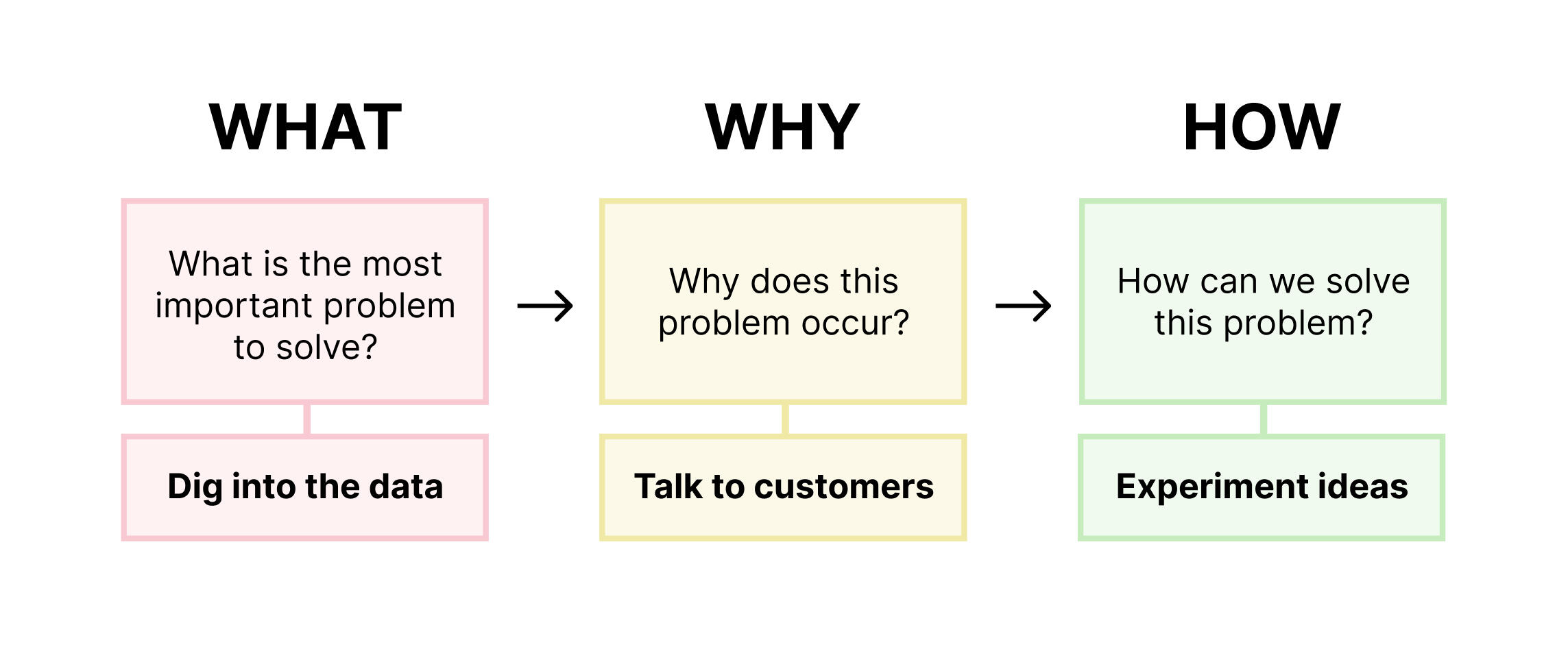
What is the most important problem to solve?
Before you start building anything, you want to make sure you’re solving your product’s most important problem. This may seem obvious, but too often I see teams skipping this step and diving straight into the solution space. Doing this means potentially missing out on an even bigger opportunity, optimizing for a local maximum rather than a global maximum.The only way to find out is by digging into the data to identify the biggest gaps, drop-offs, and customer pain-points. This should paint a much clearer picture of the most important problems facing your product and give you the confidence to set measurable goals¹ around the most impactful one.
Why does this problem occur?
Now that you’ve identified the most important problem to solve, it’s time to figure out why this problem occurs. The best way to find out is to get out of the building and talk to your customers.This step is crucial, yet it’s one of the easiest to overlook. I’ve been guilty of this myself, assuming I knew the answer only to be humbled when I watched customers actually use my product.If you don’t understand why your problem occurs, you’ll end up treating the symptoms rather than the root cause. So make sure you talk to your users and get your product in their hands. The qualitative feedback you get will be crucial to help you determine what’s really causing the problem.
How can we solve this problem?
Once you know why your problem occurs, it’s time to get together with your team to figure out how to solve it. The goal here is to come up with as many solution paths as possible, and then determine the easiest way to validate each one.By the end of this process, you should have several lightweight feature ideas that your team can quickly build and test. Start testing these ideas to validate which solution path works best, and then iterate on the winners until your problem is solved.
Repeat
Now that you’ve solved your product's most important problem, it’s time to repeat this process again with a new one. This process is not complicated, but it requires discipline. It can be tempting to cut corners to save time, but this is a surefire way to waste even more time going down the wrong path.At the end of the day, the best products are built by teams who consistently ask What, Why, and How. Make this a habit and you’ll be surprised how effective it can be!
Join my newsletter to get new posts straight to your inbox:
Notes
[1] To quote Will Larson, "good goals are a composition of four specific kinds of numbers:
A target states where you want to reach.
A baseline identifies where you are today.
A trend describes the current velocity.
A time frame sets bounds for the change.
Put these all together, and a well-structured goal takes the form of: 'In Q3, we will reduce time to render our frontpage from 600ms (p95) to 300ms (p95). In Q2, render time increased from 500ms to 600ms.'The two tests of an effective goal are whether someone who doesn’t know much about an area can get a feel for a goal’s degree of difficulty, and whether afterward they can evaluate whether it was successfully achieved. If you define all four aspects, typically your goal will fulfill both criteria."
AP Johnson — Blog — About
January 10, 2023
New Year's Resolutions
With a new year comes new resolutions. For me, this used to mean compiling a laundry list of new habits to adopt, and then trying fruitlessly to fulfill them all over the next 12 months. Turns out there is such a thing as spreading yourself too thin.Given my rocky track record with new year’s resolutions, a couple years ago I decided to try a new, more focused approach. Instead of coming up with a dozen resolutions, I asked myself only two questions:
What is one thing you could do that would dramatically improve your personal life?
What is one thing you could do that would dramatically improve your professional life?
Answering these questions forced me to isolate the one thing that mattered the most for each one, and to leave everything else behind. The power that comes from this focus is hard to understate — in the two years since I’ve adopted this approach I’ve made more progress toward my goals than I ever have before.The beauty of this process is that you can adjust it to whatever frequency suits you best. I ask myself these questions every 6 months or so to take a pulse on my goals and priorities, and adjust them if needed. A friend of mine does this every week. The key is to find a cadence that helps you maintain your focus and stay motivated as you work toward your biggest goals.Hopefully these questions can help you as much as they’ve helped me. With 2023 now upon us, it’s the perfect time to take a step back and ask yourself:What is one thing you could do that would dramatically improve your life?And then do it.
Join my newsletter to get new posts straight to your inbox:
AP Johnson — Blog — About
January 2, 2023
The Spotify Wrapped Growth Engine
When Spotify Wrapped first released in December 2016, it took social media by storm. Since then, dozens of other products have come up with their own flavour of this, with varying degrees of success.While none of the copycats have quite captured the zeitgeist the way Spotify Wrapped has, these end of year recaps have become a valuable tool to boost brand awareness, deepen brand loyalty, and drive viral growth.It’s easy to get it wrong though — just ask Loom — so to kick off 2023 I thought I would dive into this and break down the 4 keys to a successful end of year recap.
Target Active Users
Loom’s mistake was to send end of year recaps to inactive and disengaged users. Doing this is a great way to further alienate these users by reminding them how little value they got from your product this year. Instead, you should reserve end of year recaps for active users who meet a minimum engagement threshold.For instance, in 2021 Instagram Playback required users to have shared at least 3 stories in the past 12 months to access the feature. This ensured eligible users would get a good experience with their end of year Playback, while encouraging ineligible users to post more stories in the following year in order to access this feature the next time around. A true win-win!
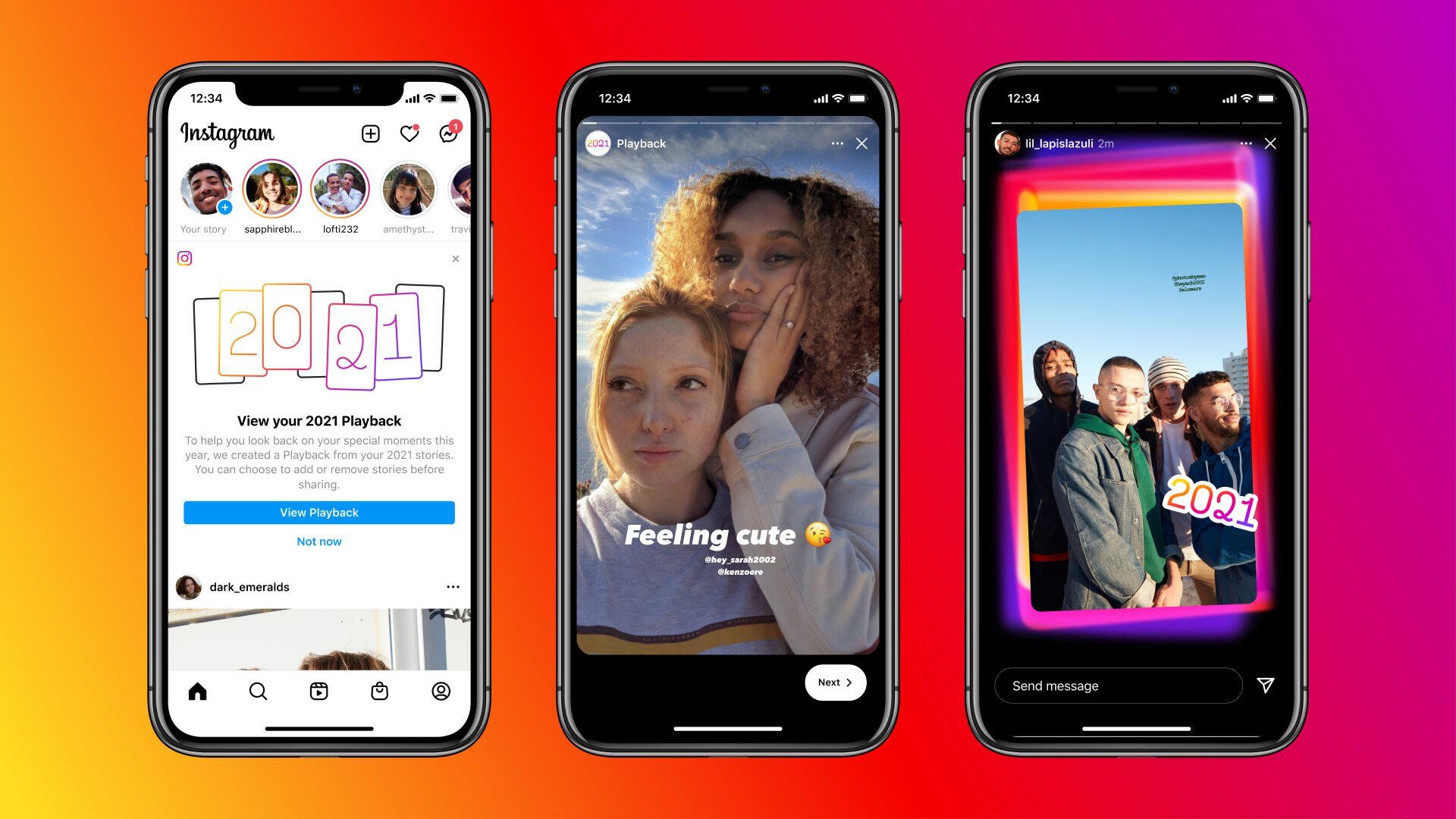
Give Users Something to Brag About
Another mistake I’ve seen in end of year recaps is sharing generic, aggregate user stats — looking at you Bolt. People don’t care about your company, they care about themselves. So show them personalized stats and milestones tailored to their individual product usage, and show them how they stack up against other users.Not only will this make your users feel more connected to your product, it will also give them something to brag about and make them more likely to share these stats with their friends. This thread on Taylor Swift’s top listeners is a perfect example.When it comes to B2B products, the same principles apply. If you can give companies something to brag about to their customers, prospects, or employees, they will jump on the opportunity to do so. See: Jobber showing off how many Donut meetings their team completed or Linear showing off how quickly they fix bugs.
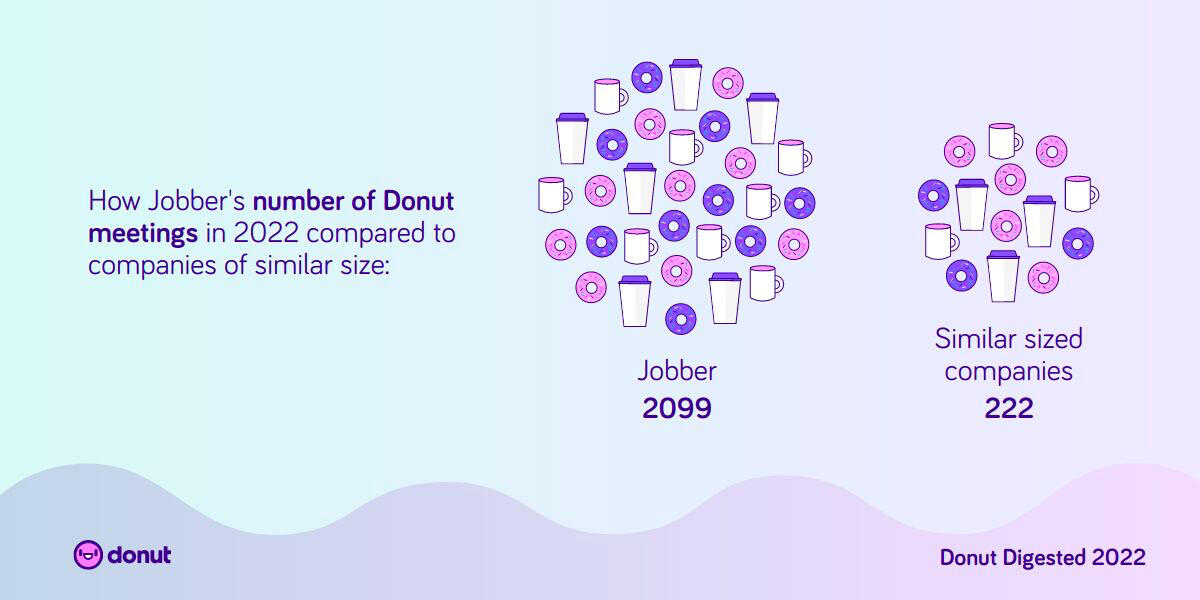
Add Personalized Content
Stats and milestones are great, but the best end of year recaps go the extra mile and add personalized content for each user.For example, this year Reddit generated a unique Collectible Avatar for each user based on how they used Reddit over the past 12 months, and Spotify told users what their listening personality was based on the songs, artists, and genres they listened to. This kind of fun, personalized content is easy to share and helps users develop a more personal connection with your product.Taking this one step further, Spotify even got artists to record thank you messages for their top listeners. Now, not only do users get to see which songs they listened to the most, they also get an exclusive thank you video from their favourite artist!Whatever your approach, adding personalized content to your end of year recap is an excellent way to stand out and deepen brand loyalty with your users.

Make It Easy to Share
One of the biggest benefits of end of year recaps is the viral growth and brand awareness they generate. But in order for this to happen, you need your users to share their recaps.The key here is to make your recap visually appealing and easy to screenshot. Nobody wants to share bland or boring content, so take the time to make the visuals fun and engaging. If your content makes your users look good, they are much more likely to share it.Spotify has done a phenomenal job at this, with their striking Spotify Wrapped designs making the rounds on social media, in private DMs, and even in-person conversations. Not only are their screens easy to screenshot, Spotify has also included several CTAs and integrations throughout the experience that make it easy for users to share their Spotify Wrapped online or with friends.
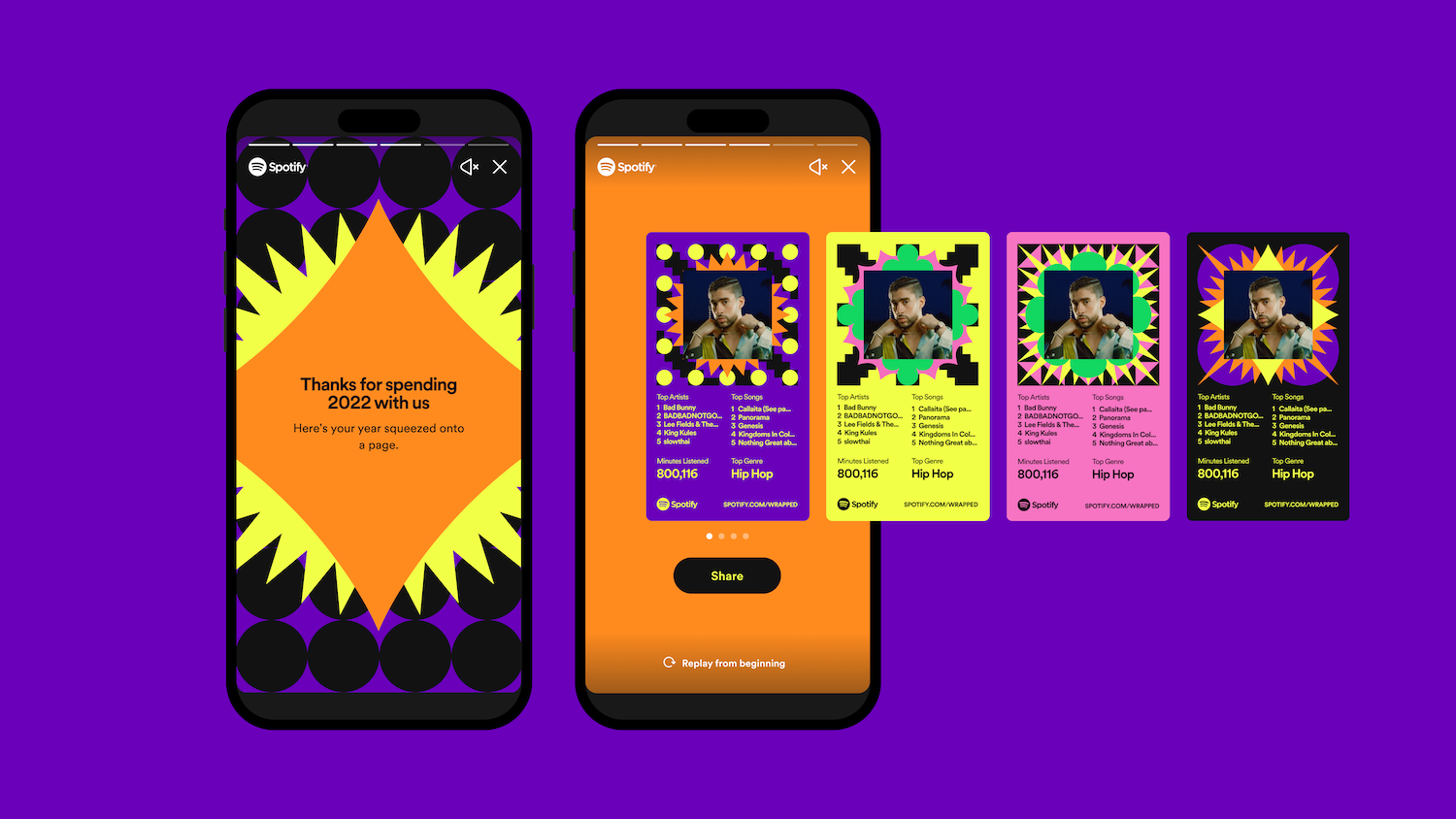
What This Means for You
If you collect data on how users interact with your product, the end of the year is the perfect time to turn this data into fun, shareable recaps. When done well, end of year recaps make your users feel more connected to your product and turn them into external advocates. They help boost brand awareness, deepen brand loyalty, and drive viral growth.That said, good end of year recaps take a lot of effort and preparation to create, and they aren't the right fit for every product.¹ So before you dive in, make sure this is something your customers and business can actually benefit from. If so, then the guidelines above should give you everything you need to create a memorable and engaging recap that keeps your users coming back for more.
Join my newsletter to get new posts straight to your inbox:
Notes
[1] See Adam Fishman's Hot Take Alert #5: No, you shouldn't do a Spotify Wrapped campaign
[Bonus] Here are some of the notable end of year recaps I’ve found so far. Let me know if I’ve missed any!Music
Games
Social Media
B2B
Other
AP Johnson — Blog — About
December 19, 2022
Stories as a Service
Fifty years ago, the entertainment industry was driven almost exclusively by passive media — movies, TV shows, sports, and the like. Over the past few decades, though, interactive media has emerged as a dominant player, with video games becoming by far the most lucrative form of entertainment and showing no signs of slowing down.This can be chalked up to a multitude of factors, but in this post I want to explore one in particular: replay value.
The Economics of Replay Value
When it comes to replay value, video games are hard to beat. Whether we’re talking about multiplayer games like Minecraft and Call of Duty or systems-driven games like Tetris and Candy Crush, players will spend hundreds of hours playing these games over and over again. This is because every game session is different, so these games don’t lose their appeal.As game developers have realized this, they’ve shifted their business model from one where revenue scales with new game releases to one where revenue scales with playtime. Instead of only making money when people buy their games, developers found ways to make money when people play their games.As a result, what we now call “Games as a Service” has emerged as the go-to business model for the world’s biggest titles. From Fortnite to FarmVille, games have found ways to monetize playing time through subscriptions, microtransactions, and ads. The more time players spend in-game, the more money these developers bring in.
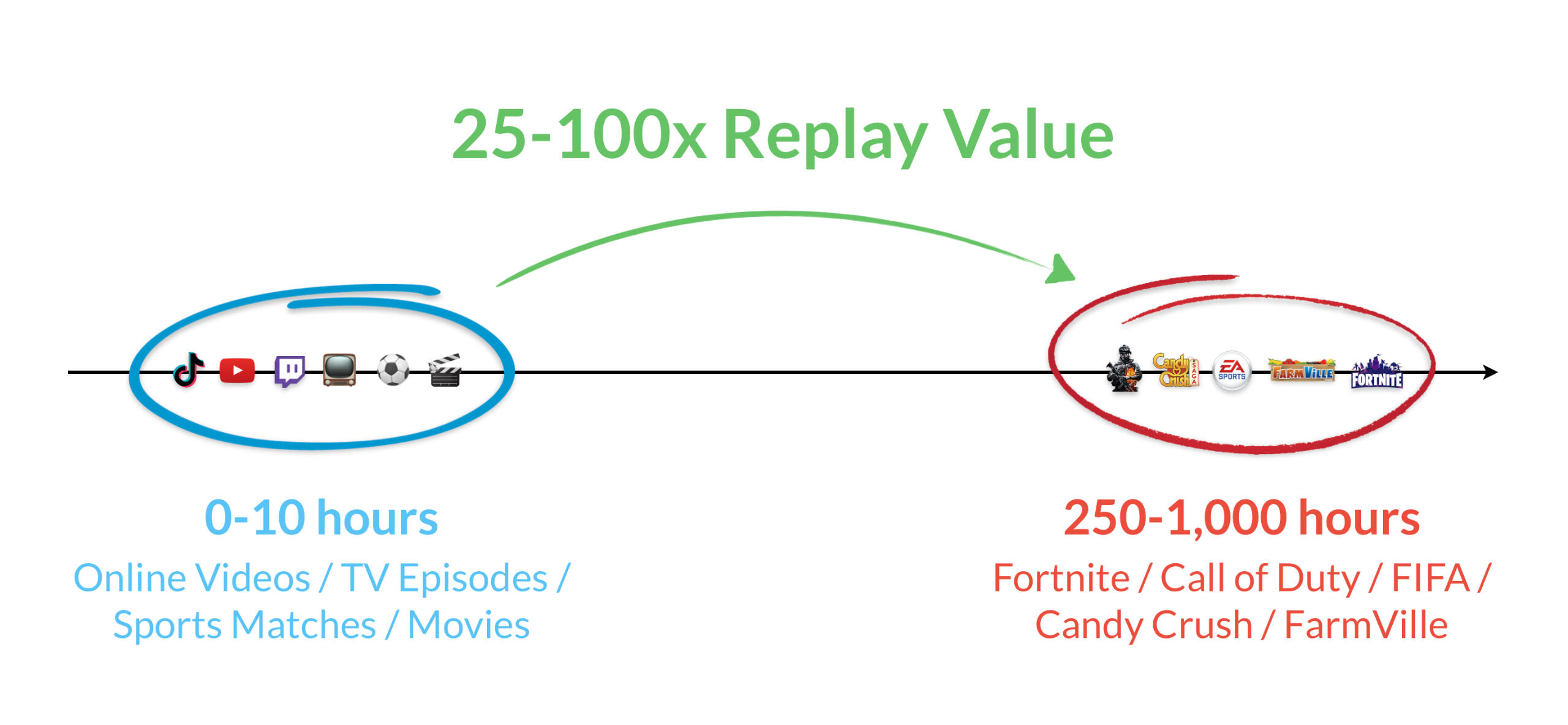
On the other hand, passive media tends to have very low replay value, mainly because it relies so heavily on stories. Once viewers know how a story ends, there isn’t much incentive to watch it again. This is why you rarely see people re-watch movies, TV episodes, sports games, or online videos more than once or twice, let alone hundreds of times.Because watch time is so limited, passive media must instead rely on new content creation to generate revenue. Movies release new sequels. TV shows release new episodes. Sports leagues broadcast new games. YouTubers upload new videos.As you can imagine, the economics of this aren’t great. Generating revenue requires a constant stream of new content, which takes time and resources to create. For the same money it costs to produce a blockbuster movie, game studios are able to produce video games with 100 times more replay value that bring in significantly more revenue.But what if we could ditch the hamster wheel of content creation? What if there was another way?
Generative Storytelling
With the advent of AI, stories are easier to create than ever before. You can ask ChatGPT to write you a story about pretty much anything, and within seconds you end up with several perfectly believable scripts about Bob, the talking balloon.
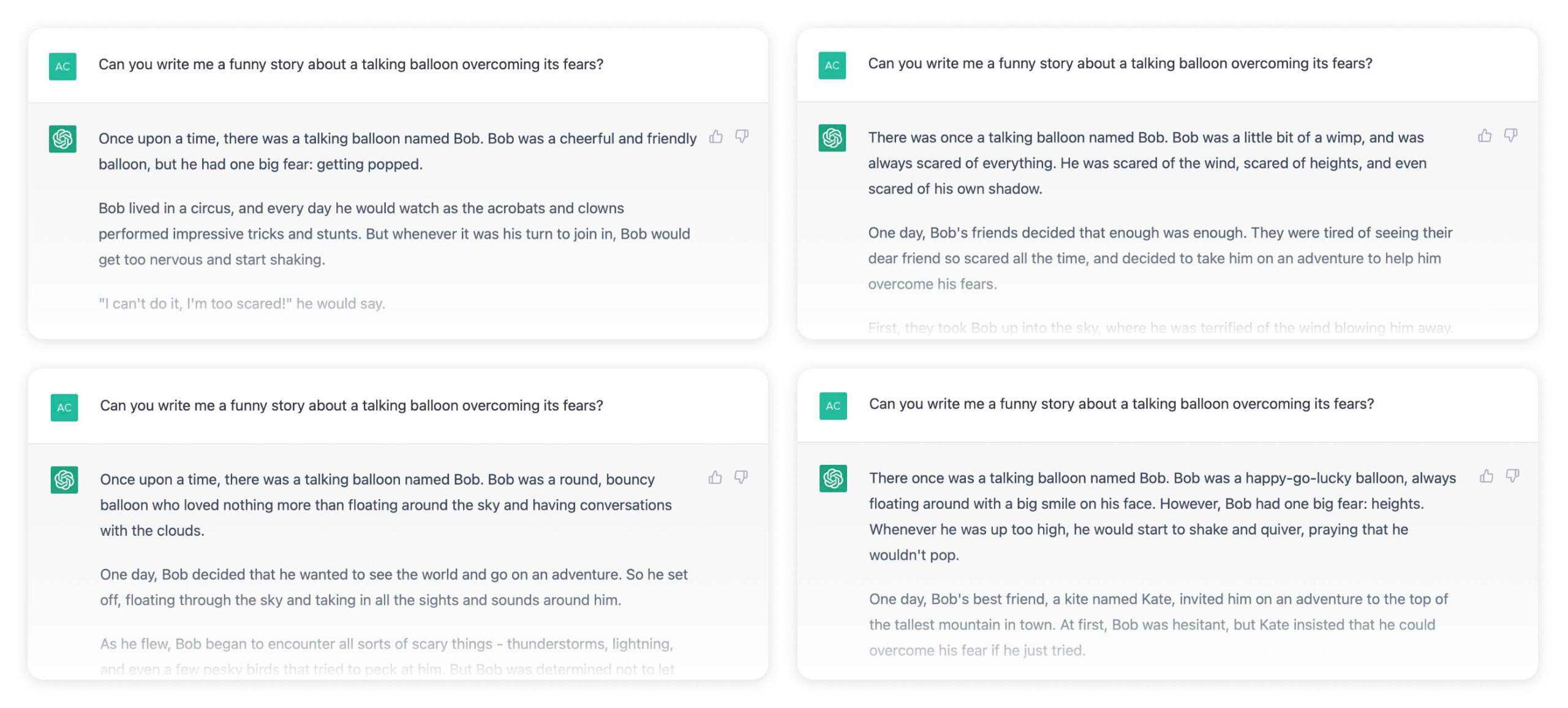
We’re not far from a future where tools like ChatGPT can be combined with advanced animation models to create Pixar-like movies using only AI. For any given set of characters, the AI could generate an infinite number of storylines, each different from the last.Just imagine the possibilities. A Star Wars movie that takes you on a different adventure every time you watch it. A crime drama with a new twist each time. Infinite Seinfeld episodes. With generative storytelling, the replay value of passive media would be through the roof.And this is just scratching the surface.What if, as David Friedberg proposed, each story was tailored to the individual viewer’s tastes & preferences? The era of hyper-personalized content is just around the corner.
Ultimately, the value of generative stories isn’t in how good they are. It’s unlikely these will compete for Oscars anytime soon. Their value lies in their diversity, which makes them exciting and unpredictable. This is what will keep viewers coming back.If passive media is to compete with games this decade, producers need to take a page out of gaming's playbook and adopt a usage-based business model. Forget Games as a Service — it’s time for Stories as a Service.
Join my newsletter to get new posts straight to your inbox:
AP Johnson — Blog — About
December 12, 2022
Forget Faster Horses
What is a problem that can't be solved today, but that could be solved if knowledge work were a million times cheaper? This is no longer a hypothetical question — it has become a very real consideration with OpenAI’s latest release.A couple weeks ago OpenAI launched ChatGPT, an AI chatbot that can do pretty much anything. From writing songs to creating exercise plans to coding entire apps, it’s the first tangible example of how AI could completely transform how our world works.
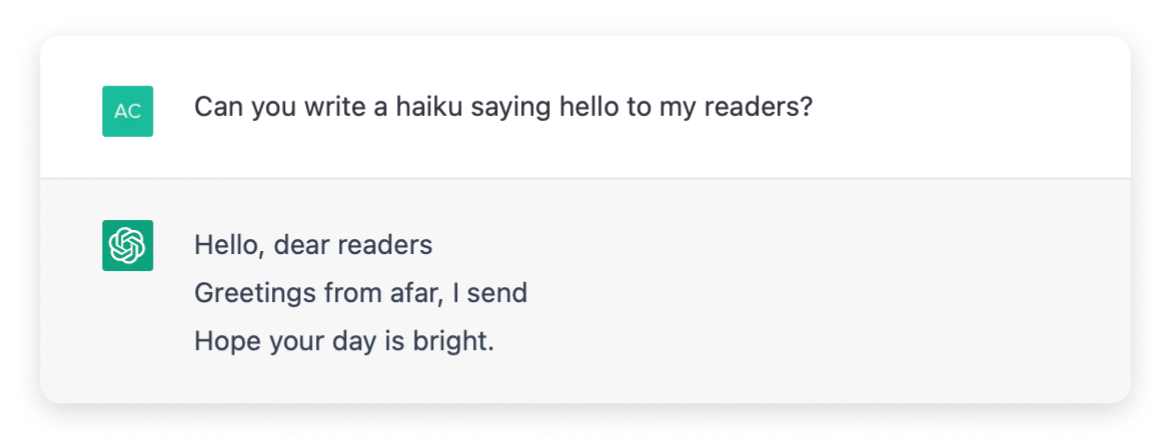
In its current state, ChatGPT still has many limitations. For one, it routinely serves up incorrect information, while doing so in a very convincing manner. As Sam Altman, the CEO of Open AI, put it, ChatGPT is great for creative inspiration, but should not be relied upon for factual queries. That said, I think Sam is underselling ChatGPT here. While it may not be good at answering questions accurately yet, it can certainly provide more than just creative inspiration.In my own experience playing with ChatGPT, I’ve found that it does quite a decent job at replicating the abilities of an entry-level copywriter, marketer, developer, author, and songwriter, among others. Mind you, the output for these types of queries is not phenomenal — it would be considered average at best by more experienced practitioners in these fields — but it’s good enough to match what I’d expect from an inexperienced entry-level worker.This got me thinking. If ChatGPT can produce the same quality of work as an entry-level knowledge worker in just a few seconds, what could it do at scale? This technology will not merely improve the efficiency of our existing systems and processes, it will enable entirely new ways of doing things we’ve never thought of before.
"If I had asked people what they wanted, they would have said faster horses."
- Henry Ford
Just like how the industrial revolution ushered in a new era of innovation by drastically decreasing the costs of production for physical goods, AI is poised to do the same with knowledge work. Having access to ChatGPT is like having access to millions of entry-level knowledge workers at a fraction of the cost. This opens up a whole new universe of possibilities:
We could give every student in the world their own personal tutor with a hyper-personalized curriculum.
We could eliminate phishing by replying to each scam email with a realistic "gullible human" response, making it impossible for scammers to find real replies among all the fakes.
We could generate songs, books, and art for each individual that are tailored to their exact tastes and preferences.
This is only scratching the surface of what will be possible with tools like ChatGPT. The key differentiator here isn’t that AI can do our work better than us, but that it can do simple tasks at a much larger scale than we ever could.Forget faster horses — AI is giving us more horses.
Join my newsletter to get new posts straight to your inbox:
AP Johnson — Blog — About
December 5, 2022
Gas isn’t the next Facebook — it’s the next Zynga
If you’ve been on tech Twitter these past couple months, you’ve probably heard of Gas. It’s a social app that lets teenagers answer polls about each other anonymously, and it has taken the app store by storm.
A couple weeks ago Gas launched in Canada, so naturally I had to try it out for myself and see what the hype is all about.First thing’s first: this is a very simple app, but it executes really well on every detail. The UX is clean and intuitive, the visuals are colourful and engaging, and the core gameplay loop is seriously addictive. Layer on a top-notch friend finder and invite flow, and it’s no surprise to see Gas dominating the charts across the continent.
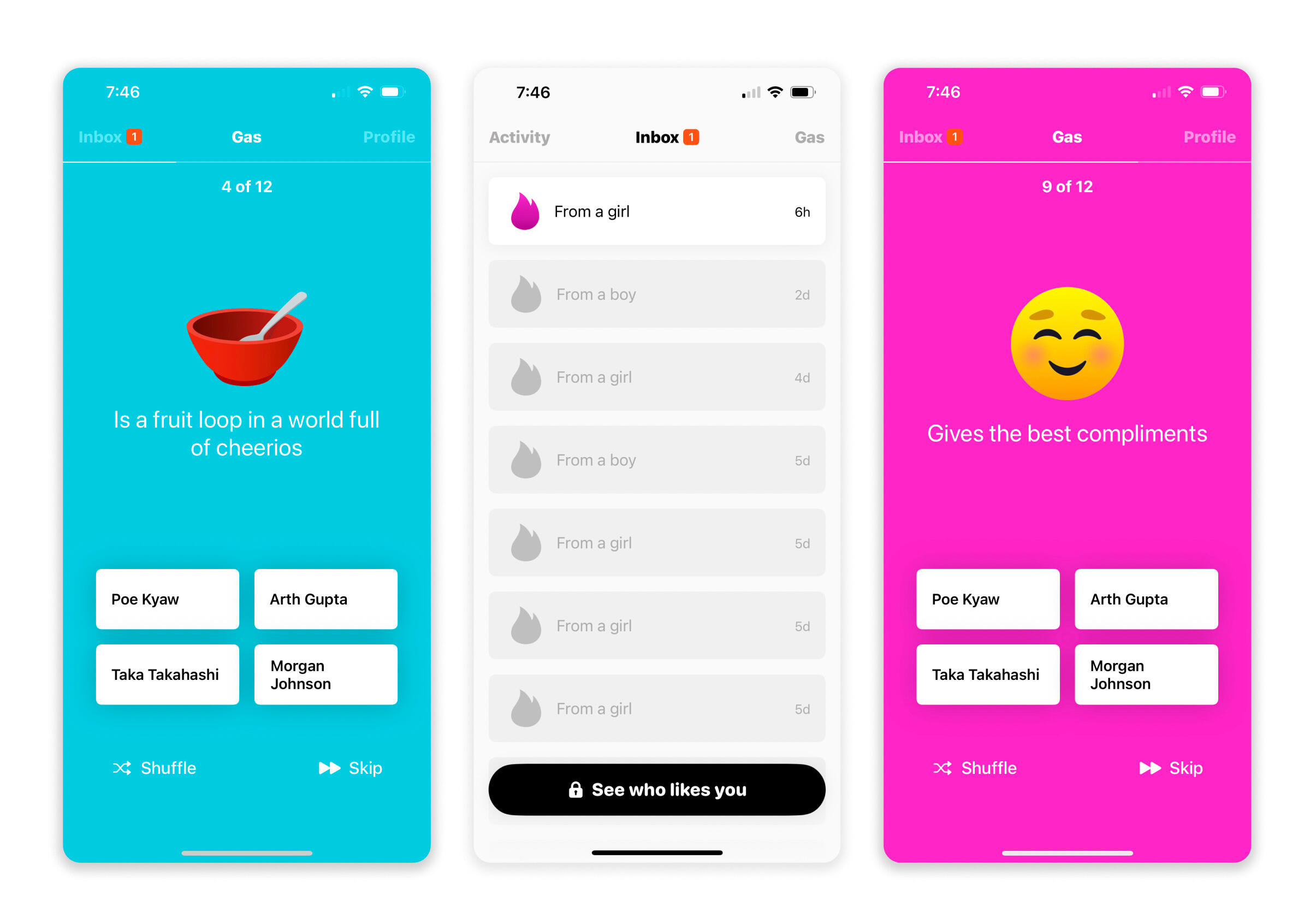
That said, the main thing that strikes me is that this app does not feel like a social network at all. Rather, it feels like a social game. You’re not sharing content, exchanging ideas, or making new friends. You’re playing the game the way it’s meant to be played: answering polls about your classmates. And like any social game, it only works if everyone is playing it. The same forces that helped Gas skyrocket to #1 within days could kill the app just as quickly if people stop playing.
"Network effects can create a very strong position, for obvious reasons. But in another sense, it’s a very weak position to be in. Because if it cracks, you just unravel."
- Marc Andreessen
There is an undeniable appeal to knowing what people think of you, but I can imagine that within a few months teenagers will get bored of this game. There’s only so many polls you can answer about your friends before it gets old.This is where Gas has a choice. To stay relevant, do they expand into a full-on social platform? Do they add in-app chat, photo-sharing, and videos (did someone say “Gas Stories”)? I’ve seen Facebook and Twitter comparisons thrown around, but I think these miss the point. Gas is not popular because it brings people together. It’s popular because it gamifies people’s need for validation. To stay relevant, Gas needs to build on this momentum and launch a new game.Social games are as old as time itself, but with millions of teens flocking to its platform, Gas has a unique opportunity to craft a new type of social gaming experience. If Zynga defined the era of Social Gaming 1.0, then Gas could define the era of Social Gaming 2.0, where games are not only played with friends, but about friends.It’s still the early days for Gas, but apps like this tend to have a short shelf life. If Gas wants to avoid the graveyard of one-hit-wonder social apps that came before it, then it should forget about social networking and double down on what it does best: making an app where the players are the game.
Join my newsletter to get new posts straight to your inbox:
AP Johnson — Blog — About
April 20, 2022
The Shit Sandwich
The infamous shit sandwich. You’ve likely been on the receiving end of quite a few, and chances are you’ve given your fair share of them as well. Why? Because the shit sandwich makes us feel like we’re softening the blow when giving negative feedback.The recipe is simple:
Start with a compliment
Give the negative/constructive feedback
End on a positive note
Seems like a great way to deliver a difficult message without hurting anyone’s feelings, right? Wrong. Not only does this tend to backfire, it’s also a sign of a weak team culture and lack of trust.Here's why you should avoid the shit sandwich, and some suggestions on what to do instead.

Why It Doesn’t Work
There are many problems with the shit sandwich, but by far the biggest problem is that it simply doesn't work. This is due to three main factors.
Mixed Messages
Being on the receiving end of a shit sandwich can be a confusing experience. Are you being praised or criticized? Are you doing a good job or not? This kind of feedback often backfires, leaving recipients thinking they’re doing well when in fact they are not.¹If your feedback is confusing or unclear, it makes it hard for the recipient to act on it and improve. Sending mixed messages doesn’t help anyone.
Prevents Growth
One of the main reasons why the shit sandwich is so popular is that people don’t like having difficult conversations. It’s much easier to avoid them altogether and give vague, positive-sounding feedback instead. I know because I’ve been this person many times before.We believe we’re being nice by sparing the recipient’s feelings and sugar-coating our feedback. But the reality is that while tough conversations may feel uncomfortable, they are the only way to foster real growth. Without them, everyone loses.
Smells Like Bullshit
Most importantly, people can smell a shit sandwich from a mile away. The fake positivity is painfully obvious and makes it difficult to connect and resonate with the person you’re talking to on any meaningful level.Not only does this kind of feedback lack authenticity, it also signals that you value appearances more than honesty. If you can’t respect your colleagues enough to be straight with them, don’t be surprised if they return the favour.
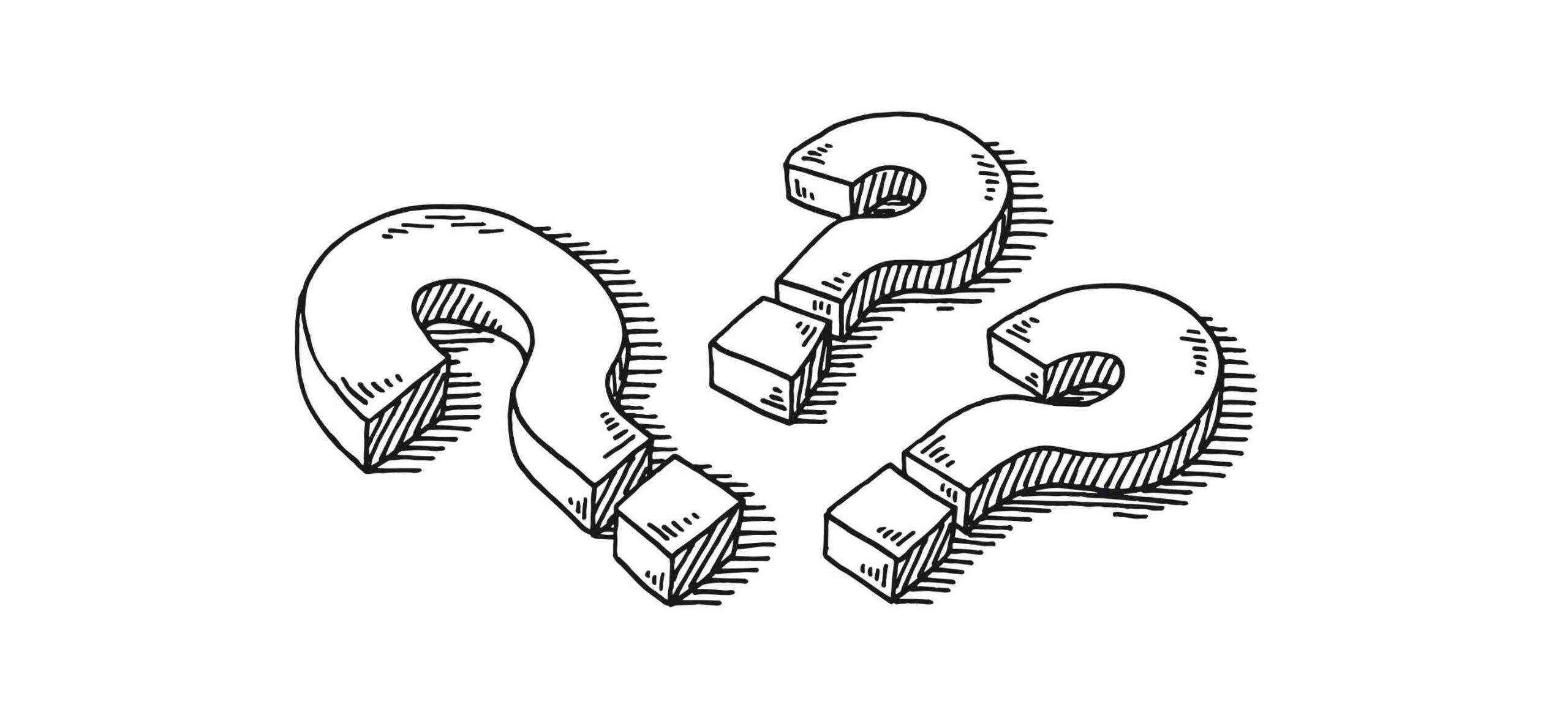
What to Do Instead
If the shit sandwich doesn’t work, then what does? There are many ways to give effective, authentic feedback that builds trust and encourages growth. Here are a few places to start.
Foster Psychological Safety
Plenty has been written about psychological safety over the past couple decades so I will defer to the experts on this one (see John Cutler's excellent post on this topic). The main takeaway here is that when teams encourage true self-expression and embrace mistakes without judgement, constructive feedback becomes much easier to both give and receive.As long as the recipient can tell it’s coming from a place of genuine care and good intentions, constructive feedback comes off as helpful and caring rather than hurtful and unkind. Difficult conversations don't have to be so difficult after all.
Tailor Feedback to the Recipient
Before you give someone feedback, consider how they would like to receive it. Each person has their own preference for this, and it’s often best to just ask them directly.One easy way to do this is to have everyone on your team write a personal user manual. These help team members get to know each other's personalities, work styles, and feedback preferences, making it much easier to give feedback that resonates with the recipient.The kind of feedback you give should also depend on the seniority of the person receiving it. According to research from the University of Chicago, beginners respond better to positive feedback and encouragement as it helps motivate them to complete their goals, whereas experts prefer constructive feedback because it helps them monitor their progress and shore up their weaknesses.²
Be Genuine and Direct
Ultimately, it all comes down to being genuine and direct with the person you’re talking to. If you’ve established a strong foundation of trust, this directness will be greatly appreciated and make it much easier for them to understand how they can improve. In return, they are much more likely to be genuine and direct with you as well. A true win-win!For more on this, I highly recommend reading Kim Scott’s Radical Candor, which provides an excellent framework for giving honest and actionable feedback.

Parting thoughts
As much as I speak out against it here, I still catch myself giving out the occasional shit sandwich. It’s a bad habit I’ve tried to shake over the years, and hopefully this post can help you shake it too.Great feedback cultures are the result of repeated, sustained efforts. As the old saying goes, practices makes perfect!
If you enjoyed this post, you can join my newsletter to get new posts straight to your inbox:
Notes
[1] In an experiment devised by Ayelet Fishbach, she split her class into two groups and got half the students to give negative feedback to the other half, one-on-one.Curiously, rather than coming out of this exercise understanding where they were failing and how they could improve, the students receiving negative feedback "thought they were doing great."She attributes this to poor feedback delivery. "The negative feedback is often buried and not very specific," she says, which leaves the wrong impression and defeats the entire purpose of the feedback.
[2] In Tell Me What I Did Wrong: Experts Seek and Respond to Negative Feedback and How Positive and Negative Feedback Motivate Goal Pursuit, researchers at the University of Chicago found that different types of feedback work best on novices and experts.The main challenge for novices is that they tend to lack motivation and commitment to their goals. Because of this, they typically respond better to positive feedback and encouragement.On the other hand, experts respond better to negative feedback since they already have sufficient motivation and instead want to track their progress and improve their weaknesses.
AP Johnson — Blog — About
March 24, 2022
User Manual to Me
When a new person joins the Growth team at Jobber, they are asked to write a “user manual to me” that is shared with the rest of the team.This is not only a great way to get to know them, it also helps us understand their preferred work style, feedback methods, and other personality quirks. It allows us to meet people where they are and be better teammates to each other.When I joined Jobber last summer, it was my turn to do a bit of self-reflection. Who is AP? What am I like? What should my new colleagues know before working with me? This exercise not only helped my team learn more about me, it also helped me learn more about myself.I would highly recommend this exercise to anyone reading this right now, whether for your team or just as an individual pursuit. You might be surprised by what you learn!

User Manual to AP
Questions about you
What are some honest, unfiltered things about you?
I’m a pretty intense person, both at work and in my personal life.
I'm very detail oriented, but can sometimes obsess over small details a bit too much. Call me out when it happens!
I love getting constructive feedback. Give it to me as often as you can — I promise I won't be offended.
What drives you nuts?
Disorganized work
Lack of accountability
Bad faith arguments
Driving slowly in the fast lane (!!)
What are your quirks?
I’m addicted to spreadsheets and love making lists.
I'm very competitive and love a good strategy game. Hit me up anytime for a round of Catan!
I'm bad at multitasking and work best when I'm laser-focused on one thing at a time.
How can people earn an extra gold star with you?
Sweat the details.
Be a beacon of positivity.
Give me frequent, honest feedback.
Have an open mind.
What qualities do you particularly value in people who work with you?
Empathy & respect — Put people first.
Optimism & positivity — Make work a fun place to be!
Humility & accountability — Leave your ego at home.
Direct, open communication — Don't beat around the bush.
What are some things that people might misunderstand about you that you should clarify?
People often think I'm an extrovert, but I'm actually quite introverted. I enjoy being social, but I need time to recharge afterward.
I can come off a bit strong when I voice my opinions, but I love hearing different viewpoints and I'm *always* willing to change my mind.
Questions about how you relate to others
How do you coach people to do their best work and develop their talents?
Give them my full trust and support from day one.
Find what truly motivates them and nurture that flame.
Care deeply about their success, and be honest and candid in my feedback.
What's the best way to communicate with you?
Leverage Notion / Figma / Github / Jira comments as much as possible to keep conversations organized and on-topic.
Slack messages are great for questions or feedback that cannot be delivered via in-app comments (see above). However, avoid DM'ing me unless absolutely necessary. Instead tag me in a public channel so others can stay in the loop and chime in as needed.
Meetings are a last resort. Only book a meeting with me if it's to discuss an urgent issue, something personal, or make a high-stakes decision.
What's the best way to convince you to do something?
Share your reasoning, thought process, and supporting evidence/data.
Get me excited about the problem we're solving. Why is it important? What impact can we have?
How do you like to give feedback?
I try to share feedback immediately as it comes up so that the context is still fresh.
My feedback is always constructive, never critical. My goal is to help you grow, not tear you down.
My feedback is always about the behaviour, not the person. If I'm giving you feedback it's because I care about you and want you to succeed.
How do you like to get feedback?
Give it to me straight. Be honest and open about your thoughts and feedback.
Show me that you care and that your feedback is coming from a good place.
Don't be afraid to share negative/critical feedback. I want to hear it so I can improve!
To get my next posts straight to your inbox, you can join my newsletter below:
Notes
The user manual format we use at Jobber is based on Adam Bryant’s template which was adapted by David Politis.
You can find some other great templates online as well. Two of my favourites are from Claire Hugues Johnson and Cassie Robinson.
For an alternative take on this topic, read Camille Fournier's I hate manager READMEs.
AP Johnson — Blog — About
June 18, 2021
My Next Chapter
Today marks exactly 50 months since I started working at Breaking Walls.At the time, I was joining a small team of game developers with a cool idea they wanted to bring to life. Fast-forward to today and we're a 7-figure business with a hit indie game on the way.Over the past four years, I've learned what it takes to grow a startup from the ground up with a small team and a limited budget. But over time, I've become even more interested in what comes next: scaling a small business into a giant.This is why after 50 wonderful months, it's time for me to embark on a new adventure.
Joining Jobber
In a couple weeks, I will be joining the growth team at Jobber to help scale their platform.As one of Canada's fastest-growing startups, Jobber is helping home service entrepreneurs across the globe manage their businesses more effectively. They recently raised $60M to fuel the next stage of their growth, and the next few years will be key in turning Jobber from a plucky startup into a household name.I'm excited to be joining such a dynamic team and I can't wait to tackle the ambitious growth challenges that lie ahead. We have an amazing opportunity to help entrepreneurs around the world, and I believe this is the team that can pull it off.
Acknowledgements
Looking back on my time at Breaking Walls, I am incredibly grateful to Sébastien, Nathanaël, and Laurent for taking a chance on me and giving me their full trust and support from day one.I also owe a lot to Sage, Anuradha, and Ghyslain for being great partners along the way. It's been a memorable journey, and I wouldn't be where I am today without them.I'm terrible at goodbyes, so this is just an à bientôt. But as I embark on this new chapter of my career, I'm excited to be joining the growth team at Jobber and can't wait to see what comes next!
P.S. If you'd like to join me, Jobber is hiring across Canada for a ton of positions!
To get my next posts straight to your inbox, you can join my newsletter below:
AP Johnson — Blog — About
May 31, 2021
The Future of Remote Work is Voice-First
Zoom fatigue.Fifteen months ago, nobody knew what this meant. But if you're reading this today, you've probably experienced it firsthand more times than you can remember.The sudden shift to remote work since the start of the pandemic has fundamentally changed how teams collaborate. Too often, though, this change has come in the form of endless video calls. Now don't get me wrong—video chat is a great tool, but it's not the one-size-fits-all solution many companies are using it as today.In fact, we're already seeing the consequences of its overuse: remote workers simply aren't collaborating as effectively as they used to in the office.¹Luckily, there is a better way.
The Case for Voice-First Collaboration
I've worked on several remote teams over the past decade, and the most effective ones were those that enthusiastically adopted voice chat in their day-to-day operations.It's not that they shunned video calls altogether, but rather they recognized most situations simply don't require video. That's because voice-first collaboration offers three main advantages:
Less Friction
When we join a video call, we're typically mindful of our appearance, location, and background. We want to look presentable for the call, which means taking more time and effort to get ready. This adds a lot of friction to what should be a simple process: chatting with teammates.With audio calls, we don't have to worry about any of that. We can just hop on a call and chat, no matter where we are or what we look like in that moment.It may sound trivial, but this makes a big difference when it comes to team collaboration. When conversations with colleagues don't feel like formal, performative events, it's much easier to jump in and out of quick calls. This leads to more ad-hoc conversations and a smoother flow of information across the entire organization.
Fewer Distractions
If you've ever watched competitive gamers communicate with each other, you'll notice that they only ever use voice chat. That's because video adds unnecessary cognitive load and actually distracts from the task at hand.This same logic also applies to our workplace, especially for tasks that require more concentration. Whether we're collaborating on a document, reviewing code, or working on a new design together, what's important is what's on the screen, not what's behind the camera.With audio calls, we can remove unnecessary distractions and reduce cognitive load, freeing up more mental space (and screen real estate) to focus on the work in front of us.
Less Exhausting
Have you ever come out of a long day of video calls feeling absolutely drained? You're not alone. What we call "Zoom fatigue" is very real, and voice chat seems to be the antidote.Research has shown that audio calls feel much less taxing than video calls.² This not only has a major impact on our productivity, but also on our mood. We feel more energized, patient, and engaged, which leads to better collaboration for everyone involved.
Why We Still Need Video
While voice chat has many advantages over video, there is one important reason why the latter still remains a valuable piece of the remote collaboration puzzle:Video is great for building trust.In a study led by the University of Michigan in 2001, researchers found that groups interacting via video were able to achieve the same levels of trust and cooperation as those interacting face-to-face. Meanwhile, audio and text-based collaboration lagged behind.³

This has important implications for remote teams, since building trust is essential for effective collaboration.One of the main reasons why video works so well for this is that it conveys much more information than voice alone. The presence of facial expressions and non-verbal cues allows for more subtle expressions of tone and emotion, which leads to clearer communication and fewer misunderstandings.This makes video chat the perfect tool for "high-EQ conversations" such as one-on-ones, performance reviews, and team bonding activities. And in the absence of face-to-face interactions, nothing beats video for building trust and rapport with people you're meeting for the first time. That's why sales calls, client meetings, and investor pitches are all best conducted via video.
How It All Fits Together
As a general rule, voice chat should play a larger role in internal communications while we reserve video for external meetings and high-EQ conversations.For instance, when onboarding new hires, meeting over video can help teams develop the trust and rapport they need to foster a strong team culture. But once they've built up this rapport, transitioning to a voice-first approach can help them unlock the next level of effective collaboration.As more companies embrace remote work for the long haul, they will have to strike the right balance between voice and video. We are already seeing more workplaces making voice chat the default for internal collaboration, and I expect many more to follow.We are still in the early days of the remote revolution, but I believe that when it comes to collaboration, adopting a voice-first approach to remote work will be what separates the good teams from the great ones.
If you enjoyed this post, you can join my newsletter to get new posts straight to your inbox:
Notes
[1] In a BCG survey last year of over 12,000 employees across Germany, India, and the United States, 56% of employees reported feeling less productive on collaborative tasks since switching to remote work.
[2] In Nonverbal Overload: A Theoretical Argument for the Causes of Zoom Fatigue (2021), Stanford researchers identified four main causes for so-called "Zoom Fatigue:"
Excessive amounts of close-up eye contact is highly intense.
Seeing yourself during video chats constantly in real-time is fatiguing.
Video chats dramatically reduce our usual mobility.
The cognitive load is much higher in video chats.
One of the solutions they propose is to "make 'audio only' Zoom meetings the default, or better yet, insist on taking some calls via telephone to free your body from the frustrum."
[3] In Being there versus seeing there: Trust via video (2001), University of Michigan researchers found that groups collaborating over video chat achieved the same levels of trust as those interacting face-to-face.Given enough time, groups collaborating via audio (over the phone) were also able to achieve similar levels of trust, albeit more slowly than via video or face-to-face.
[Bonus] Last year, Daniel Gross shared some interesting thoughts on digital communication. Among other ideas, he suggests that video calls are draining because people don't look as good as in real life:"You’re looking [at] humans from a very unnatural angle. They’re badly lit. It’s not a fun movie. Your mind is comparing it to reality and it’s far less engaging."He also offers up voice chat as a possible solution to this problem:"Audio is better because we can approach the natural modality. FaceTime Audio is as good as physical audio, but Zoom is a far cry from physical video. Unless you have a production-grade TV rig and lighting, it might be best for you to go audio-only."This theory hasn't been properly studied yet, but it's interesting to ponder nonetheless.
[Bonus] Some people have asked for recommendations on the best tools for voice-first communication. I am personally a big fan of "virtual office" platforms like Tandem, Presence, and Teamflow.Rajiv Ayyangar recently wrote a great post on why virtual offices are so valuable to remote teams. I highly recommend reading it if you're interested in exploring this further.
[Update: August 2021] The American Psychological Association recently published their findings on the effects of camera use in virtual meetings. To quote Adam Grant, they found that turning off video "reduces exhaustion and boosts engagement—especially for women and newcomers. Cameras off doesn't reflect disengagement. It helps to prevent burnout and promote attention."
AP Johnson — Blog — About
July 6, 2020
Managing Remote Teams
As a manager, it’s your job to make sure information flows smoothly within your team.Without this, you can't build trust, get timely feedback, or empower your teammates. Projects get held up, team morale plummets, and productivity grinds to a halt.In office settings, information tends to flow relatively freely via informal conversations, body language, and ease of access to your colleagues. Because of this, you can get away with a lack of structure and poorly-defined processes since so much information is conveyed implicitly within your team.In remote settings, though, these implicit information sources disappear.As a result, managing a remote team requires much more intentionality and preparation. It becomes your primary responsibility to put in place the right processes to keep information flowing smoothly within your team.There is no silver bullet, but here are six things you can do to become a better remote manager.
Over-Communicate
When your team isn’t in the same building, it’s harder to make sure everyone’s on the same page.To avoid misunderstandings or mismatched expectations, make sure you’re communicating often and explicitly with the rest of your team, no matter how unnecessary it may feel.Trust me, they will appreciate it.
Write Everything Down
And when I say everything, I mean everything.Documenting your work is important in any project, but it is especially crucial for remote teams.With colleagues spread across several locations, clear and consistent documentation helps everyone stay up to date with what’s going on in your project.
Be Patient
In remote teams, you never know when someone’s gone to the bathroom, in a meeting, or otherwise unavailable. So be patient and don’t expect immediate responses all the time.Not only does this give your colleagues room to breathe, it also frees them up to focus, get in the zone, and do their best work.Fewer time-sensitive interruptions = better work & happier team.
Make Time for Friendship
When you’re working remotely, it’s harder to get to know your colleagues personally. No more watercooler conversations, shared lunches, or after-work drinks.So set aside some time for team-building. Not only does it make work more fun, it also builds trust and keeps everyone happy and engaged.A few ideas…👋 Daily/weekly non-work video chats❓ Teammate trivia🎪 Fun/informal Slack channels🎲 Online party games📚 Book clubs🎥 Movie nights🍻 Local meetups
Embrace Voice Chat
Remote work can be lonely, but endless video calls are not the solution. They're inefficient, exhausting, and often completely overkill.Instead, many remote work veterans I know default to voice chat for internal conversations. It offers the same level of presence, collaboration, and information bandwidth while reducing cognitive load and feeling less performative.With platforms like Tandem, Presence, and even Discord, you can migrate your team online without sacrificing proximity or spontaneity. Your office may be virtual, but when set up properly it feels just like you’re working next to each other, minus the commute.
All or Nothing
If only some of your team works remotely, then you're setting yourself up for failure.In "hybrid" remote set-ups, remote team members end up missing out on all the conversations that happen in person, and this uneven distribution of information heavily favours team members working in the office.If you want to switch to remote (even temporarily), you have to commit all the way.With your whole team working remotely, the flow of information moves from the office into the digital realm (email/Slack/Notion/Github/etc.). This ensures everyone is included and kept in the loop, and gives everyone an equal voice on your team.
Bottom Line
Ultimately, your job as a manager is to empower your team to do their best work, and in a remote setting this requires a lot more thought and preparation. From communicating more clearly to building stronger relationships, your success as a remote manager will depend on your ability to manage the flow of information within your team.Every team is different and has its own unique needs, so hopefully these guidelines can serve as a helpful starting point.
This is my first foray into writing and I'll be sharing more thoughts on remote management in future essays, so feel free to reach out! I'd love to hear your thoughts as well.If you enjoyed reading this, you can join my newsletter to get my next essays straight to your inbox:
« Previous Post | Next Post »

